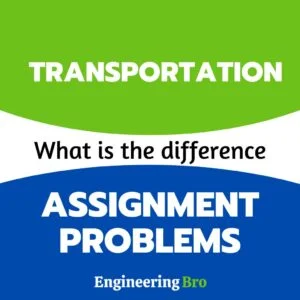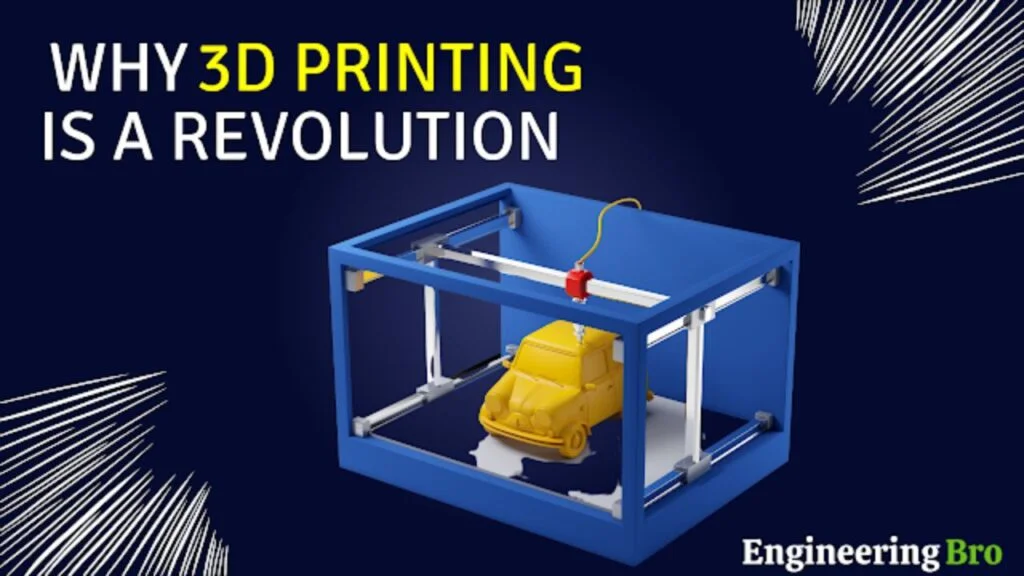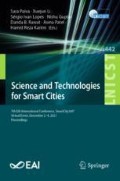

Difference between transportation and assignment problems?
Lets understand the difference between transportation and assignment problems.
Transportation problems and assignment problems are two types of linear programming problems that arise in different applications.
The main difference between transportation and assignment problems is in the nature of the decision variables and the constraints.
If you’re unable to see the whole table kindly convert the mobile view to the desktop view

Additional Different between Transportation and Assignment Problems are as follows :
Decision Variables:
In a transportation problem, the decision variables represent the flow of goods from sources to destinations. Each variable represents the quantity of goods transported from a source to a destination.
In contrast, in an assignment problem, the decision variables represent the assignment of agents to tasks. Each variable represents whether an agent is assigned to a particular task or not.
Constraints:
In a transportation problem, the constraints ensure that the supply from each source matches the demand at each destination and that the total flow of goods does not exceed the capacity of each source and destination.
In contrast, in an assignment problem, the constraints ensure that each task is assigned to exactly one agent and that each agent is assigned to at most one task.
Objective function:
The objective function in a transportation problem typically involves minimizing the total cost of transportation or maximizing the total profit of transportation.
In an assignment problem, the objective function typically involves minimizing the total cost or maximizing the total benefit of assigning agents to tasks.
In summary,
The transportation problem is concerned with finding the optimal way to transport goods from sources to destinations,
while the assignment problem is concerned with finding the optimal way to assign agents to tasks.
Both problems are important in operations research and have numerous practical applications.
Checkout Home page for more informative content and Follow us on facebook for more
Related Posts

3d printing design revolution or intellectual property nightmare
Introduction to 3D printing In this article, we will closely look at the intellectual property rights for 3D printing and […]

HVAC Engineer Salary, Roles, Responsibilities, Qualification
Who is an HVAC Engineer? An HVAC engineer is one who manages heating, ventilation, and air conditioning Plan designed and […]
Copyright © 2003 by Robert Fourer, David M. Gay and Brian W. Kernighan
Operations Research/Transportation and Assignment Problem
The Transportation and Assignment problems deal with assigning sources and jobs to destinations and machines. We will discuss the transportation problem first.
Suppose a company has m factories where it manufactures its product and n outlets from where the product is sold. Transporting the product from a factory to an outlet costs some money which depends on several factors and varies for each choice of factory and outlet. The total amount of the product a particular factory makes is fixed and so is the total amount a particular outlet can store. The problem is to decide how much of the product should be supplied from each factory to each outlet so that the total cost is minimum.
Let us consider an example.
Suppose an auto company has three plants in cities A, B and C and two major distribution centers in D and E. The capacities of the three plants during the next quarter are 1000, 1500 and 1200 cars. The quarterly demands of the two distribution centers are 2300 and 1400 cars. The transportation costs (which depend on the mileage, transport company etc) between the plants and the distribution centers is as follows:
Which plant should supply how many cars to which outlet so that the total cost is minimum?
The problem can be formulated as a LP model:

The whole model is:
subject to,

The problem can now be solved using the simplex method. A convenient procedure is discussed in the next section.
- Book:Operations Research
Navigation menu
Balanced and Unbalanced Transportation Problems
The two categories of transportation problems are balanced and unbalanced transportation problems . As we all know, a transportation problem is a type of Linear Programming Problem (LPP) in which items are carried from a set of sources to a set of destinations based on the supply and demand of the sources and destinations, with the goal of minimizing the total transportation cost. It is also known as the Hitchcock problem.
Introduction to Balanced and Unbalanced Transportation Problems
Balanced transportation problem.
The problem is considered to be a balanced transportation problem when both supplies and demands are equal.
Unbalanced Transportation Problem
Unbalanced transportation problem is defined as a situation in which supply and demand are not equal. A dummy row or a dummy column is added to this type of problem, depending on the necessity, to make it a balanced problem. The problem can then be addressed in the same way as the balanced problem.
Methods of Solving Transportation Problems
There are three ways for determining the initial basic feasible solution. They are
1. NorthWest Corner Cell Method.
2. Vogel’s Approximation Method (VAM).
3. Least Call Cell Method.
The following is the basic framework of the balanced transportation problem:

The destinations D1, D2, D3, and D4 in the above table are where the products/goods will be transported from various sources O1, O2, O3, and O4. The supply from the source Oi is represented by S i . The demand for the destination Dj is d j . If a product is delivered from source Si to destination Dj, then the cost is called C ij .
Let us now explore the process of solving the balanced transportation problem using one of the ways known as the NorthWest Corner Method in this article.
Solving Balanced Transportation problem by Northwest Corner Method
Consider this scenario:

With three sources (O1, O2, and O3) and four destinations (D1, D2, D3, and D4), what is the best way to solve this problem? The supply for the sources O1, O2, and O3 are 300, 400, and 500, respectively. Demands for the destination D1, D2, D3, and D4 are 250, 350, 400, and 200, respectively.
The starting point for the North West Corner technique is (O1, D1), which is the table’s northwest corner. The cost of transportation is calculated for each value in the cell. As indicated in the diagram, compare the demand for column D1 with the supply from source O1 and assign a minimum of two to the cell (O1, D1).
Column D1’s demand has been met, hence the entire column will be canceled. The supply from the source O1 is still 300 – 250 = 50.

Analyze the northwest corner, i.e. (O1, D2), of the remaining table, excluding column D1, and assign the lowest among the supply for the appropriate column and rows. Because the supply from O1 is 50 and the demand for D2 is 350, allocate 50 to the cell (O1, D2).
Now, row O1 is canceled because the supply from row O1 has been completed. Hence, the demand for Column D2 has become 350 – 50 = 50.

The northwest corner cell in the remaining table is (O2, D2). The shortest supply from source O2 (400) and the demand for column D2 (300) is 300, thus putting 300 in the cell (O2, D2). Because the demand for column D2 has been met, the column can be deleted, and the remaining supply from source O2 is 400 – 300 = 100.

Again, find the northwest corner of the table, i.e. (O2, D3), and compare the O2 supply (i.e. 100) to the D2 demand (i.e. 400) and assign the smaller (i.e. 100) to the cell (O2, D2). Row O2 has been canceled because the supply from O2 has been completed. Column D3 has a leftover demand of 400 – 100 = 300.

Continuing in the same manner, the final cell values will be:

It should be observed that the demand for the relevant columns and rows is equal in the last remaining cell, which was cell (O3, D4). In this situation, the supply from O3 was 200, and the demand for D4 was 200, therefore this cell was assigned to it. Nothing was left for any row or column at the end.
To achieve the basic solution, multiply the allotted value by the respective cell value (i.e. the cost) and add them all together.
I.e., (250 × 3) + (50 × 1) + (300 × 6) + (100 × 5) + (300 × 3) + (200 × 2) = 4400.
Solving Unbalanced Transportation Problem
An unbalanced transportation problem is provided below. Because the sum of all the supplies, O1, O2, O3, and O4, does not equal the sum of all the demands, D1, D2, D3, D4, and D5, the situation is unbalanced.

The idea of a dummy row or dummy column will be applied in this type of scenario. Because the supply is more than the demand in this situation, a fake demand column will be inserted, with a demand of (total supply – total demand), i.e. 117 – 95 = 22, as seen in the image below. A fake supply row would have been introduced if demand was greater than supply.

Now this problem has been changed to a balanced transportation problem, and it can be addressed using any of the ways listed below to solve a balanced transportation problem, such as the northwest corner method mentioned earlier.
Frequently Asked Questions on Balanced and Unbalanced Transportation Problems
What is meant by balanced and unbalanced transportation problems.
The problem is referred to as a balanced transportation problem when both supplies and demands are equal. Unbalanced transportation is defined as a situation where supply and demand are not equal.

What is called a transportation problem?
The transportation problem is a type of Linear Programming Problem in which commodities are carried from a set of sources to a set of destinations while taking into account the supply and demand of the sources and destinations, respectively, in order to reduce the total cost of transportation.
What are the different methods to solve transportation problems?
The following are three approaches to solve the transportation issue:
- NorthWest Corner Cell Method.
- Least Call Cell Method.
- Vogel’s Approximation Method (VAM).
Leave a Comment Cancel reply
Your Mobile number and Email id will not be published. Required fields are marked *
Request OTP on Voice Call
Post My Comment
- Share Share
Register with BYJU'S & Download Free PDFs
Register with byju's & watch live videos.

Implementation and Comparison of Four Algorithms on Transportation Problem
- Conference paper
- First Online: 17 June 2022
- Cite this conference paper

- Eghbal Hosseini 22 ,
- Line Reinhardt 22 ,
- Kayhan Zrar Ghafoor 23 &
- Danda B. Rawat 24
Part of the book series: Lecture Notes of the Institute for Computer Sciences, Social Informatics and Telecommunications Engineering ((LNICST,volume 442))
Included in the following conference series:
- International Summit Smart City 360°
1032 Accesses
The transportation problem is a very applicable and relevant logistic problem. In this paper, to test meta-heuristics on the transportation problem and also improve initial feasible solutions in few number of iterations, four recent and effective meta-heuristic algorithms are used to solve transportation problems. Laying Chicken Algorithm (LCA), Volcano Eruption Algorithm (VEA), COVID-19 Optimizer Algorithm (CVA), and Multiverse Algorithm (MVA) are implemented to solve different sizes of the transportation problem. Computational results show that CVA is the most efficient optimizer for large size cases and LCA is the best algorithm for the others. Finally, convergence of algorithms will be discussed and rate of convergence will be compared. The advantage of these heuristics are that they can be easily adapted to more challenging versions of the transportation problem which are not solveable by the Simplex method.
- Transportation problems
- Meta-heuristic algorithm
This is a preview of subscription content, log in via an institution to check access.
Access this chapter
- Available as PDF
- Read on any device
- Instant download
- Own it forever
- Available as EPUB and PDF
- Compact, lightweight edition
- Dispatched in 3 to 5 business days
- Free shipping worldwide - see info
Tax calculation will be finalised at checkout
Purchases are for personal use only
Institutional subscriptions
Aizemberg, L., Kramer, H.H., Pessoa, A.A., Uchoa, E.: Formulations for a problem of petroleum transportation. Eur. J. Oper. Res. 237 (1), 82–90 (2014). https://doi.org/10.1016/j.ejor.2014.01.036
Article MathSciNet MATH Google Scholar
Amaliah, B., Fatichah, C., Suryani, E.: A new heuristic method of finding the initial basic feasible solution to solve the transportation problem. J. King Saud Univ. Comput. Inf. Sci. 22 (2020)
Google Scholar
Cosma, O., Pop, P.C., Dănciulescu, D.: A novel matheuristic approach for a two-stage transportation problem with fixed costs associated to the routes. Comput. Oper. Res. 118 , 104906 (2020). https://doi.org/10.1016/j.cor.2020.104906
Hosseini, E.: Laying chicken algorithm: a new meta-heuristic approach to solve continuous programming problems. J. Appl. Comput. Math. 6 (1), 1–8 (2017)
Article Google Scholar
Hosseini, E., Sadiq, A.S., Ghafoor, K.Z., Rawat, D.B., Saif, M., Yang, X.: Volcano eruption algorithm for solving optimization problems. Neural Comput. Appl. 33 (7), 2321–37 (2021)
Hosseini, E., Ghafoor, K.Z., Sadiq, A.S., Guizani, M., Emrouznejad, A.: Covid-19 optimizer algorithm, modeling and controlling of coronavirus distribution process. IEEE J. Biomed. Health Inf. 24 (10), 2765–2775 (2020)
Hosseini, E., Ghafoor, K.Z., Emrouznejad, A., Sadiq, A.S., Rawat, D.B.: Novel metaheuristic based on multiverse theory for optimization problems in emerging systems. Appl. Intell. 11 , 1–8 (2020)
Juman, Z.A., Hoque, M.A.: An efficient heuristic to obtain a better initial feasible solution to the transportation problem. Appl. Soft Comput. 1 (34), 813–26 (2015)
Juman, Z.A.M.S., Hoque, M.A., Buhari, M.I.: A sensitivity analysis and an implementation of the Wellknown Vogel’s approximation method for solving unbalanced transportation problem. Malays. J. Sci. 32 (1), 66–72 (2013)
Ramadan, S.Z., Ramadan, I.Z.: Hybrid two-stage algorithm for solving transportation problem. Mod. Appl. Sci. 6 (4), 12 (2012)
Soriano, A., Vidal, T., Gansterer, M., Doerner, K.: The vehicle routing problem with arrival time diversification on a multigraph. Eur. J. Oper. Res. 286 (2), 564–575 (2020)
Article MathSciNet Google Scholar
Download references
Author information
Authors and affiliations.
Department of People and Technology, Roskilde University, Roskilde, Denmark
Eghbal Hosseini & Line Reinhardt
Department of Software Engineering, Salahaddin University-Erbil, Erbil, 44002, Kurdistan Region, Iraq
Kayhan Zrar Ghafoor
Department of Electrical Engineering and Computer Science, Howard University, Washington, DC, USA
Danda B. Rawat
You can also search for this author in PubMed Google Scholar
Corresponding author
Correspondence to Kayhan Zrar Ghafoor .
Editor information
Editors and affiliations.
Instituto Politécnico de Viana do Castelo, Viana do Castelo, Portugal
Auckland University of Technology, Auckland, New Zealand
Sérgio Ivan Lopes
SRM Institute of Science and Technology, Chennai, India
Nishu Gupta
Howard University, Washington, DC, USA
Stoke-on-Trent, Birmingham, UK
Politecnico di Milano, Milan, Italy
Hamid Reza Karimi
Rights and permissions
Reprints and permissions
Copyright information
© 2022 ICST Institute for Computer Sciences, Social Informatics and Telecommunications Engineering
About this paper
Cite this paper.
Hosseini, E., Reinhardt, L., Ghafoor, K.Z., Rawat, D.B. (2022). Implementation and Comparison of Four Algorithms on Transportation Problem. In: Paiva, S., et al. Science and Technologies for Smart Cities. SmartCity 360 2021. Lecture Notes of the Institute for Computer Sciences, Social Informatics and Telecommunications Engineering, vol 442. Springer, Cham. https://doi.org/10.1007/978-3-031-06371-8_28
Download citation
DOI : https://doi.org/10.1007/978-3-031-06371-8_28
Published : 17 June 2022
Publisher Name : Springer, Cham
Print ISBN : 978-3-031-06370-1
Online ISBN : 978-3-031-06371-8
eBook Packages : Computer Science Computer Science (R0)
Share this paper
Anyone you share the following link with will be able to read this content:
Sorry, a shareable link is not currently available for this article.
Provided by the Springer Nature SharedIt content-sharing initiative
- Publish with us
Policies and ethics
- Find a journal
- Track your research

IMAGES
VIDEO
COMMENTS
7. Identify the relationship between assignment problems and transportation problems. 8. Formulate a spreadsheet model for an assignment problem from a description of the problem. 9. Do the same for some variants of assignment problems. 10. Give the name of an algorithm that can solve huge assignment problems that are well
Prasad A Y, Dept of CSE, ACSCE, B'lore-74. Page 33. Module 4: Transportation Problem and Assignment problem. This means that programmer 1 is assigned programme C, programmer 2 is assigned programme A, and so on. The minimum time taken in developing the programmes is = 80 + 80 + 100 + 90 = 350 min.
154 Chapter5. Thetransportationproblemandtheassignmentproblem min z = (8 , 6 , 10 , 10 , 4 , 9) x11 x12 x13 x21 x22 x23 subjectto
The transportation problem is concerned with finding the optimal way to transport goods from sources to destinations, while the assignment problem is concerned with finding the optimal way to assign agents to tasks. Both problems are important in operations research and have numerous practical applications.
Figure 8: Constructing a transportation problem 4.3.2 Mathematical model of a transportation problem Before we discuss the solution of transportation problems we will introduce the notation used to describe the transportation problem and show that it can be formulated as a linear programming problem. We use the following notation; x
Identify the relationship between assignment problems and transportation problems. Formulate a spreadsheet model for an assignment problem from a description of the problem. Do the same for some variants of assignment problems. Give the name of an algorithm that can solve huge assignment problems that are well beyond the scope of Solver.
Transportation and Related Problems. In this section, we will discuss several special types of linear programs. These are the transportation problems, the assignment problems, and the transshipment problems. The standard scenario where a transportation problem arises is that of sending units of a product across a network of highways that ...
TRANSPORTATION AND ASSIGNMENT MODELS CHAPTER 3. 3.1 A linear program for the transportation problem. Suppose that we have decided (perhaps by the methods described in Chapter 1) to produce steel coils at three mill locations, in the following amounts: GARY. Gary, Indiana 1400. CLEV. Cleveland, Ohio 2600. PITT. Pittsburgh, Pennsylvania 2900
The Transportation and Assignment problems deal with assigning sources and jobs to destinations and machines. We will discuss the transportation problem first. Suppose a company has m factories where it manufactures its product and n outlets from where the product is sold. Transporting the product from a factory to an outlet costs some money ...
The Simplex Method for Transportation Problems. Illustrative Examples and a Note on Degeneracy. The Simplex Tableau Associated with a Transportation Tableau. The Assignment Problem: (Kuhn's) Hungarian Algorithm. Alternating Path Basis Algorithm for Assignment Problems. A Polynomial-Time Successive Shortest Path Approach for Assignment Problems
7.5. Assignment Problems. Assignment problem: A balanced transportation problem where all supplies and demands are equal to 1. All the supplies and demands for the Machineco problem (and for any assignment problem) are integers, so all variables in Machineco's optimal solution must be integers. Solve with Transportation simplex.
Transportation Problem: Assignment Problem: 1. This is about reducing the cost of transportation merchandise: 1. This is about assigning finite sources to finite destinations where only one destination is allotted for one source with a minimum cost: 2. Number of sources and number of demand need not be equal: 2.
Transportation Problem deals with the optimal distribution of goods or resources from multiple sources to multiple destinations. While Assignment Problem deals with allocating tasks, jobs, or resources one-to-one. These LPP methods are used for cost minimization, resource allocation, supply chain management, workforce planning, facility ...
In the second part of this chapter, an assignment problem is discussed, which involves assigning people to tasks. The Hungarian method for solving assignment problems is presented. Various formulations for the problems are provided along with their solutions. All learning outcomes, solved examples, and questions are mapped with Bloom's ...
(i) A transportation problem is concerned with transportation method or selecting routes in a product distribution network among the manufacture plant and distribution warehouse situated in different regions or local outlets. (ii) We solve an assignment problem by using two methods. (a) Completer enumeration method.
Step 1: Find a row or column with only one unlined zero and circle it. (If all rows/columns have two or more unlined zeroes choose an arbitrary zero.) Step 2: If the circle is in a row with one zero, draw a line through its column. If the circle is in a column with one zero, draw a line through its row.
Abstract. Transportation and assignment problems are traditional examples of linear programming problems. Although these problems are solvable by using the techniques of Chapters 2-4 directly, the solution procedure is cumbersome; hence, we develop much more efficient algorithms for handling these problems.
In linear programming problem, assignment problem is introducing instantly after transportation problem [1]. The main aim of the assignment problem is to minimize total cost or time of several resources to an equal number of activities [1]. Assignment problem holds a condition that one resource can connect with only one activity [2].
Transportation Problem: Assignment Problem: 1. This is about reducing cost of transportation merchandise: 1. This is about assigning finite sources to finite destinations where only one destination is allotted for one source with minimum cost: 2. Number of sources and number of demand need not be equal: 2.
Unbalanced Transportation Problem. Unbalanced transportation problem is defined as a situation in which supply and demand are not equal. A dummy row or a dummy column is added to this type of problem, depending on the necessity, to make it a balanced problem. The problem can then be addressed in the same way as the balanced problem.
One of the significant linear programming problems is the transportation problem which is used for inventory, assignment and traffic [1, 8, 10, 11].In the transportation problem a product is transported from a set of sources to a set of destinations minimizing the transportation cost while satisfying the demand, the mathematical formulation has been shown in ()-().
In the transport task, the vertices are cities, and the edges represent available roads. 2. Review of transportation problems 2.1. Basic transportation problem This is the simplest form of the transportation problem, where the goal is to find the cheapest way to transport a given amount of goods from a set of sources to a set of destinations.
Share Share. Answer:- 1) Transportation issue, alludes to a particular sort of direct programming issue, which figures out which products are shipped from a bunch of sources to which set of objections, contingent upon the organic market of the sources and objecti …. View the full answer.